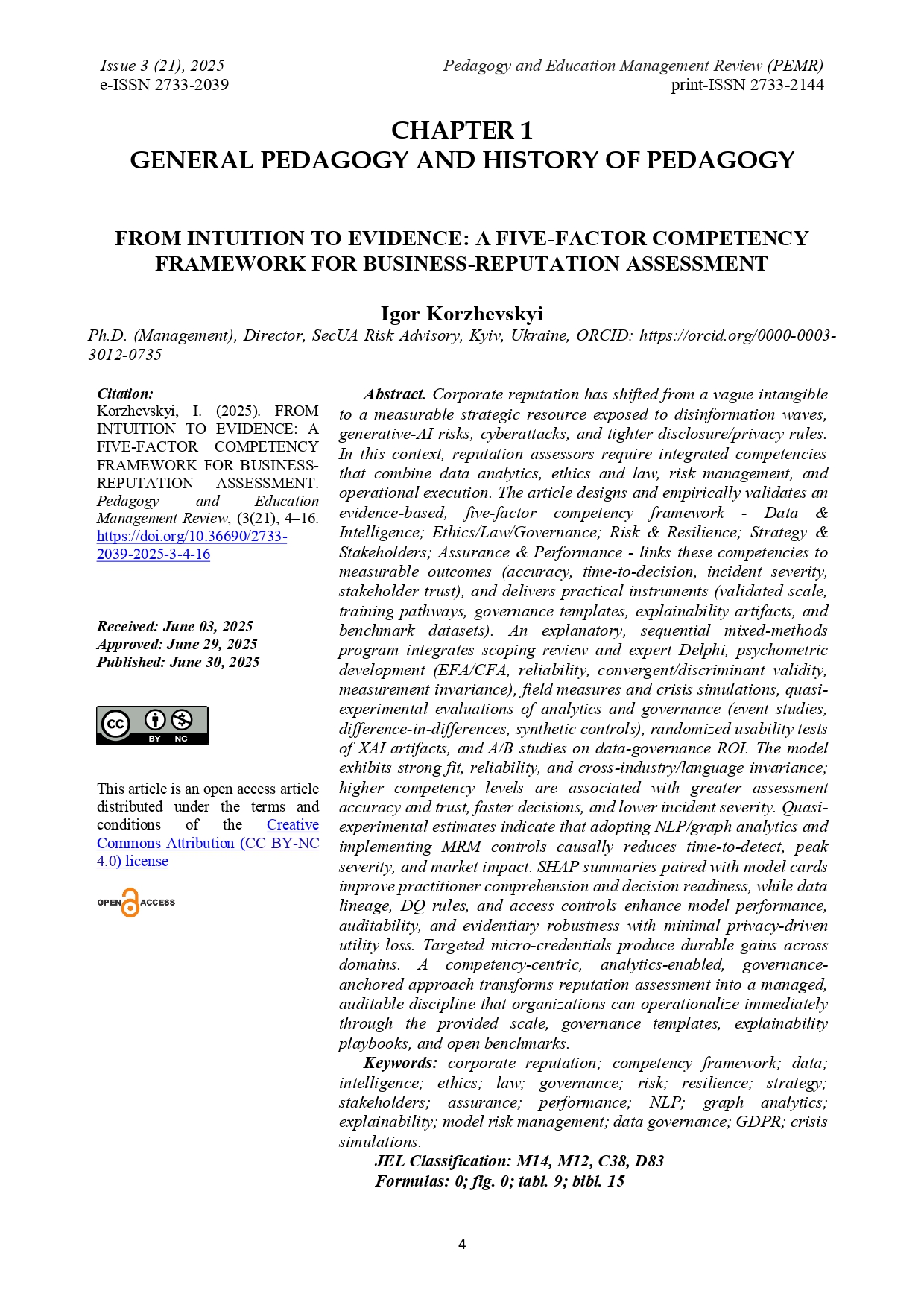FROM INTUITION TO EVIDENCE: A FIVE-FACTOR COMPETENCY FRAMEWORK FOR BUSINESS-REPUTATION ASSESSMENT
DOI:
https://doi.org/10.36690/2733-2039-2025-3-4-16Keywords:
corporate reputation, competency framework, data, intelligence, ethics, law, governance, risk, resilience, strategy, stakeholder, assurance, performance, NLP, graph analytics, explainability, model risk management, data governance, GDPR, crisis simulationsAbstract
Corporate reputation has shifted from a vague intangible to a measurable strategic resource exposed to disinformation waves, generative-AI risks, cyberattacks, and tighter disclosure/privacy rules. In this context, reputation assessors require integrated competencies that combine data analytics, ethics and law, risk management, and operational execution. The article designs and empirically validates an evidence-based, five-factor competency framework - Data & Intelligence; Ethics/Law/Governance; Risk & Resilience; Strategy & Stakeholders; Assurance & Performance - links these competencies to measurable outcomes (accuracy, time-to-decision, incident severity, stakeholder trust), and delivers practical instruments (validated scale, training pathways, governance templates, explainability artifacts, and benchmark datasets). An explanatory, sequential mixed-methods program integrates scoping review and expert Delphi, psychometric development (EFA/CFA, reliability, convergent/discriminant validity, measurement invariance), field measures and crisis simulations, quasi-experimental evaluations of analytics and governance (event studies, difference-in-differences, synthetic controls), randomized usability tests of XAI artifacts, and A/B studies on data-governance ROI. The model exhibits strong fit, reliability, and cross-industry/language invariance; higher competency levels are associated with greater assessment accuracy and trust, faster decisions, and lower incident severity. Quasi-experimental estimates indicate that adopting NLP/graph analytics and implementing MRM controls causally reduces time-to-detect, peak severity, and market impact. SHAP summaries paired with model cards improve practitioner comprehension and decision readiness, while data lineage, DQ rules, and access controls enhance model performance, auditability, and evidentiary robustness with minimal privacy-driven utility loss. Targeted micro-credentials produce durable gains across domains. A competency-centric, analytics-enabled, governance-anchored approach transforms reputation assessment into a managed, auditable discipline that organizations can operationalize immediately through the provided scale, governance templates, explainability playbooks, and open benchmarks.
Downloads
References
Barnett, M. L., Jermier, J. M., & Lafferty, B. A. (2006). Corporate reputation: The definitional landscape. Corporate Reputation Review, 9(1), 26–38. https://doi.org/10.1057/palgrave.crr.1550012
Board of Governors of the Federal Reserve System. (2011). Supervisory Letter SR 11-7: Guidance on Model Risk Management. https://www.federalreserve.gov/supervisionreg/srletters/sr1107.htm
Coombs, W. T. (2007). Protecting organization reputations during a crisis: The development and application of situational crisis communication theory. Corporate Reputation Review, 10(3), 163–176. https://doi.org/10.1057/palgrave.crr.1550049
DAMA International. (2017/2024). The DAMA-DMBOK: Data Management Body of Knowledge (2nd ed., revised ed. FAQs). https://dama.org/dama-dmbok2-revised-edition-faqs/
Eccles, R. G., Newquist, S. C., & Schatz, R. (2007). Reputation and its risks. Harvard Business Review, 85(2), 104–114. URL: https://hbr.org/2007/02/reputation-and-its-risks
Fombrun, C. J., Gardberg, N. A., & Sever, J. M. (2000). The Reputation Quotient: A multi-stakeholder measure of corporate reputation. Corporate Reputation Review, 3(1), 5–26. URL: https://shorturl.at/eGsu4
Hamilton, W. L., Ying, R., & Leskovec, J. (2017/2018). Representation learning on graphs: Methods and applications. IEEE Data Engineering Bulletin. https://doi.org/10.48550/arXiv.1709.05584
ICO & The Alan Turing Institute. (2020, updated). Explaining decisions made with AI. https://shorturl.at/MCpFv
International Organization for Standardization. (2019). ISO 22301:2019 Security and resilience—Business continuity management systems—Requirements. https://shorturl.at/Bgbci
Liu, B. (2012). Sentiment analysis and opinion mining. Morgan & Claypool. (Author’s draft) https://doi.org/10.1007/978-3-031-02145-9
National Institute of Standards and Technology (NIST). (2023). Artificial Intelligence Risk Management Framework (AI RMF 1.0) (NIST AI 100-1). https://nvlpubs.nist.gov/nistpubs/ai/nist.ai.100-1.pdf
National Institute of Standards and Technology (NIST). (2024). AI RMF: Generative AI Profile (NIST AI 600-1). https://nvlpubs.nist.gov/nistpubs/ai/NIST.AI.600-1.pdf
Regulation (EU) 2016/679 of the European Parliament and of the Council of 27 April 2016 (General Data Protection Regulation). (2016). Official Journal of the European Union, L119, 1–88. https://eur-lex.europa.eu/eli/reg/2016/679/oj/eng
Tolosana, R., Verdoliva, L., et al. (2020). Deepfakes and beyond: A survey of face manipulation and fake detection. Information Fusion, 64, 131–148. https://doi.org/10.1016/j.inffus.2020.06.014
Walker, K. (2010). A systematic review of the corporate reputation literature: Definition, measurement, and theory. Corporate Reputation Review, 12(4), 357–387. https://doi.org/10.1057/crr.2009.26







